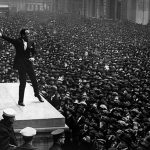 The Great Man Theory has a long and prestigious history. Formulated in the 19th century, it posits that highly influential people are able to use their power to shape the course of history.
The Great Man Theory has a long and prestigious history. Formulated in the 19th century, it posits that highly influential people are able to use their power to shape the course of history.
It sounds odd that a spider can help provide insight into the theory, but that’s what new research from UC Santa Barbara suggests. The researchers examined the behavior of African social spiders Stegodyphus dumicola. The team were especially looking to observe the leadership dynamics and the tendency for members of the group to change their behavior based upon their interactions with influential members of the group.
The analysis revealed that social susceptibility was less influenced by key members of the group as it was by the behavior of the majority of the group, and it’s this that drives leadership.
“We knew from previous studies that in a social group, the rare presence of bold individuals—who constitute between 1 and 5 percent of a population—radically changes collective behavior,” they say. “This new research evaluates whether the rise and fall of societies could be contingent on having just one or a few of these key individuals and whether the profitability of their presence might change based on the environment.”
Exploring leadership
In total, the team followed 240 colonies, some of whom contained bold leaders, whilst others did not. Their behavior was tracked for six months. The boldness of particular spiders was tested by exposing them to a jet of air. This species of spider cannot see very well, and so use air movement to determine threats from predators. The typical response is to tuck into a ball and feign death, but bolder spiders wouldn’t hold that pose for long, whereas shyer ones would hold if for up to an hour.
“We wanted to see whether the presence of these particularly bold individuals changed how a society behaves collectively, and whether the aggressiveness of a society determined the likelihood of its members surviving or dying together in a sudden extinction event,” the team say. “We found no association between how a society behaved and whether it lived or died at wet sites; nor did bold individuals have a large effect on colony behavior at these sites. However, we found a very tight association between the presence of bold individuals and societal aggressiveness at arid sites, and colonies containing bold individuals were far more likely to survive in these habitats.”
Some rare personality types existed throughout the colonies, so it was possible for the researchers to examine whether such types emerged more in particular circumstances. It transpired that the population majority had a big influence in this, thus casting doubt on the Great Man Theory, at least in spider colonies.
“When we took bold individuals from a wet site, where they didn’t have any social influence, and put them with shy spiders from an arid site, those shy individuals were willing to follow the bold ones regardless of where they were from,” the researchers continue. “So, it wasn’t the unique social influence of bold individuals from arid sites but rather the social susceptibility of the population majority that made an advantageous social order emerge.”
Of course, the question remains how transferable these findings are to human communities, but it is interesting nonetheless.